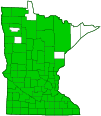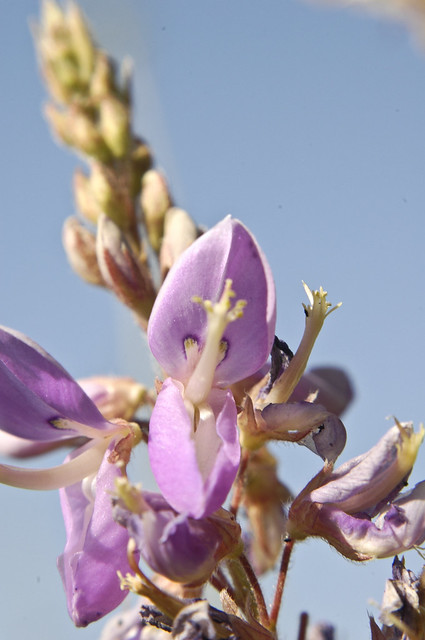Canadian tick-trefoil
(Desmodium canadense)
Conservation • Wetland • Description • Habitat • Ecology • Use • Distribution • Taxonomy
Description |
||
Canadian tick-trefoil is a 36″ to 72″ tall, erect, perennial forb that rises from a long, slender taproot. It often forms colonies. The stems are erect or strongly ascending. They are usually unbranched below the inflorescence and branched within the inflorescence. They are covered with minute, short, white, hooked hairs and longer, soft, white, spreading hairs, at least near the top. The leaves are alternate and are pinnately divided into 3 leaflets. They are on leaf stalks (petioles) that are up to 1″ long near the base of the plant, becoming shorter as they ascend the stem. Upper leaves are nearly stalkless. At the base of each compound leaf is a pair of leaf-like appendages (stipules). The stipules are linear awl-shaped, 3 ⁄16″ to 5 ⁄16″ long, and finely hairy. The terminal leaflet of mid-stem leaves is oblong or lance-shaped, 2″ to 3½″ long, up to ⅝″ wide, and on a relatively long leaflet stalk (petiolule). The blade is more than 4 times as long as it is wide and is much longer than the petiole and petiolule together. It is symmetrical, rounded at the base, and angled or short-pointed at the tip. The upper surface is green and is covered with minute, fine, hooked hairs and longer, soft, appressed hairs. The lower surface is paler green and is covered with soft, appressed hairs but does not have hooked hairs. The margins are untoothed and are fringed with minute hairs. The lateral leaflets are similar but smaller, asymmetrical, and on very short petiolules. The inflorescence is a branched array (panicle) of densely-flowered, 8″ to 12″ long, unbranched, spike-like clusters (racemes) of numerous flowers at the end of the stem. The racemes are subtended by small but conspicuous leaf-like appendages (bracts). The bracts are lance-shaped to egg-shaped and ⅜″ to 7 ⁄16″ long. They are conspicuous at flowering time but soon fall off. Each flower is ⅜″ to ½″ across measured vertically and is attached to the central axis by a hairy, red, 3 ⁄16″ to 5 ⁄16″ long stalk (pedicel). There are 5 greenish sepals (calyx) fused at the base into a short, 3 ⁄16″ to ¼″ long, hairy tube, then separated into 2 lips. The 5 petals are reddish-pink or bluish-purple, becoming dark blue when they wilt. They form a butterfly-like corolla, typical of plants in the Pea family. They are organized into a banner petal at the top, 2 lateral wing petals, and between the wings 2 petals fused into a keel. The banner is divided into 2 lobes that are fused for most of their length, making the banner appear notched at the tip. It has 2 purple-rimmed yellow spots near the base. There are 10 stamens, 9 of them fused together forming a sheath around the pistil, the uppermost 1 free. There is no floral scent. The flowers produce no nectar. They are pollinated by large, pollen collecting bees. Before pollination the banner is strongly bent backward near the base, the lobes rising vertically; the lateral wings covering the keel; and the wing-covered keel held nearly straight, parallel to the ground. After landing on a flower a bee forces wings apart and away from the banner. This causes the keel to snap downward violently releasing the column with an explosion of pollen. The fruit is a flat, slightly curved pod (loment) on a 1 ⁄16″ to ⅛″ long stalk. It is about 1″ long and is divided into 3 to 5 triangular segments. When ripe the segments separate into single-seeded, 3 ⁄16″ to ¼″ long joints (articles). The articles have an almost straight upper margin, a rounded lower margin, and a dense covering of hooked hairs. They are spread by clinging to the fur of passing animals and to the jeans and socks of passing hikers. |
||
Height |
||
36″ to 72″ |
||
Flower Color |
||
Purple to pink |
||
Similar Species |
||
Hoary tick-trefoil (Desmodium canescens) petioles are much longer, nearly as long as the terminal leaflet. The flowers are slightly smaller, about ⅜″ long. Illinois tick-trefoil (Desmodium illinoense) petioles are much longer, 2″ to 3½″ long. The stipules egg-shaped, not lance-shaped; are broader; and are twice as long, ⅜″ to ⅝″ long. The lower surface of the leaflet has hooked hairs. The flowers are pale purple or white and are slightly smaller, 5 ⁄16″ to ⅜″ long. The pedicels are longer, ½″ to ⅞″ long. There are usually only a few flowers in bloom at any one time. The loment has 2 to 5 segments that are well rounded on both the upper and lower margins. The articles are round or oval, not triangular. Pointed-leaved tick-trefoil (Desmodium glutinosum) leaves are grouped near the middle of the stem, appearing whorled. |
||
Habitat |
||
Moist to wet. Thickets, riverbanks, streambanks. |
||
Ecology |
||
Flowering |
||
July to August |
||
Pests and Diseases |
||
|
||
Use |
||
|
||
Distribution |
||||
|
Sources |
|||
| 3/22/2023 | ||||
Nativity |
||||
Native |
||||
Occurrence |
||||
Common |
||||
Taxonomy |
|||
| Kingdom | Plantae (Plants) | ||
| Division | Tracheophyta (Vascular Plants) | ||
| Subdivision | Spermatophytina (Seed Plants) | ||
| Class | Magnoliopsida (Dicots) | ||
Order |
Fabales (Legumes, Milkworts, and Allies) | ||
Family |
Fabaceae (Legumes) | ||
| Subfamily | Faboideae | ||
| Tribe | Desmodieae | ||
| Subtribe | Desmodiinae | ||
| Genus | Desmodium (ticktrefoils) | ||
Synonyms |
|||
| Meibomia canadensis | |||
Common Names |
|||
Canada tickclover Canadian tick-trefoil showy tick-trefoil showy ticktrefoil |
|||
Glossary
Bract
Modified leaf at the base of a flower stalk, flower cluster, or inflorescence.
Compound leaf
A leaf that is divided into leaflets, each leaflet having the general appearance of a leaf, with all leaflets attached to a single leaf stem.
Loment
A seedpod that is constricted between the seeds and breaks apart into one-seeded segments when mature.
Panicle
A pyramidal inflorescence with a main stem and branches. Flowers on the lower, longer branches mature earlier than those on the shorter, upper ones.
Pedicel
On plants: the stalk of a single flower in a cluster of flowers. On insects: the second segment of the antennae. On Hymenoptera and Araneae: the narrow stalk connecting the thorax to the abdomen: the preferred term is petiole.
Petiole
On plants: The stalk of a leaf blade or a compound leaf that attaches it to the stem. On ants and wasps: The constricted first one or two segments of the rear part of the body.
Petiolule
The stalk of a leaflet blade on a compound leaf.
Pinnate
On a compound leaf, having the leaflets arranged on opposite sides of a common stalk. On a bryophyte, having branches evenly arranged on opposite sides of a stem.
Raceme
An unbranched, elongated inflorescence with stalked flowers. The flowers mature from the bottom up.
Stipule
A small, leaf-like, scale-like, glandular, or rarely spiny appendage found at the base of a leaf stalk, usually occurring in pairs and usually dropping soon.
Visitor Photos |
|||||
Share your photo of this plant. |
|||||
| This button not working for you? Simply email us at info@MinnesotaSeasons.com. Attach one or more photos and, if you like, a caption. |
|||||
Alfredo Colon |
|||||
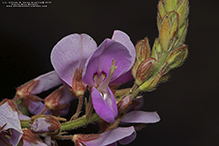 |
|||||
Luciearl |
|||||
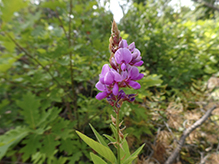 |
|||||
MinnesotaSeasons.com Photos |
|||||
Colony |
|||||
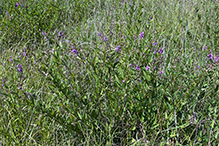 |
|||||
Plant |
|||||
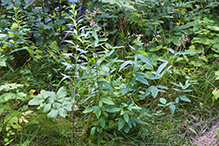 |
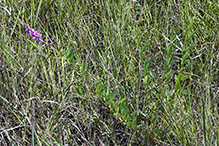 |
||||
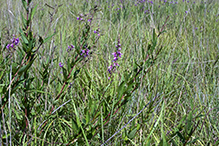 |
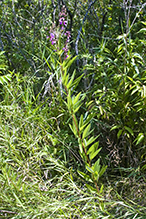 |
||||
Inflorescence |
|||||
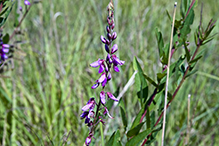 |
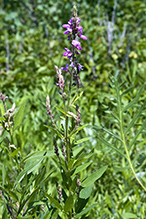 |
||||
Flowers |
|||||
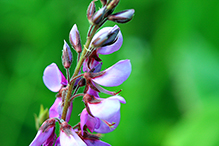 |
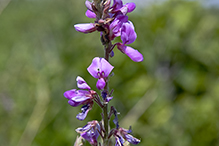 |
||||
 |
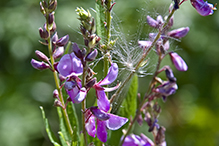 |
||||
Leaves |
|||||
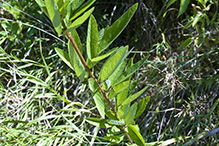 |
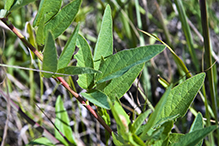 |
||||
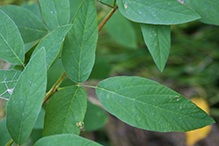 |
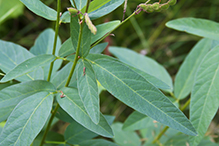 |
||||
Stem |
|||||
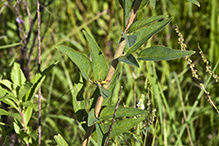 |
|||||
Fruit |
|||||
 |
|||||

Visitor Videos |
|||
Share your video of this plant. |
|||
| This button not working for you? Simply email us at info@MinnesotaSeasons.com. Attach a video, a YouTube link, or a cloud storage link. |
|||
Other Videos |
|||
| Showy Tick Trefoil - Desmodium canadense blooming at Ion Exchange, inc. Ionxchange |
|||
About
Uploaded on Aug 1, 2011 Earthyman views Showy Tick Trefoil (Desmodium canadense) blooming at Ion Exchange in Northeast Iowa. http://www.ionxchange.com |
|||

Visitor Sightings |
|||||
Report a sighting of this plant. |
|||||
| This button not working for you? Simply email us at info@MinnesotaSeasons.com. Be sure to include a location. |
|||||
| Alfredo Colon 8/5/2019 |
Location: Woodbury, Minnesota |
 |
|||
| Luciearl 8/14/2018 |
Location: Fairview Twp. |
 |
|||
MinnesotaSeasons.com Sightings |
|||||
Carver Highlands WMA, South Unit Charles A. Lindbergh State Park Lake Alexander Woods SNA, South Unit Margherita Preserve-Audubon Prairie Minnesota Valley NWR, Rapids Lake Unit Mound Spring Prairie SNA, North Unit Northern Tallgrass Prairie NWR, Hoffman Unit Northern Tallgrass Prairie NWR, Touch the Sky Prairie Unit Sand Prairie Wildlife Management and Environmental Education Area |
|||||

|
Created: Last Updated: © MinnesotaSeasons.com. All rights reserved. |
